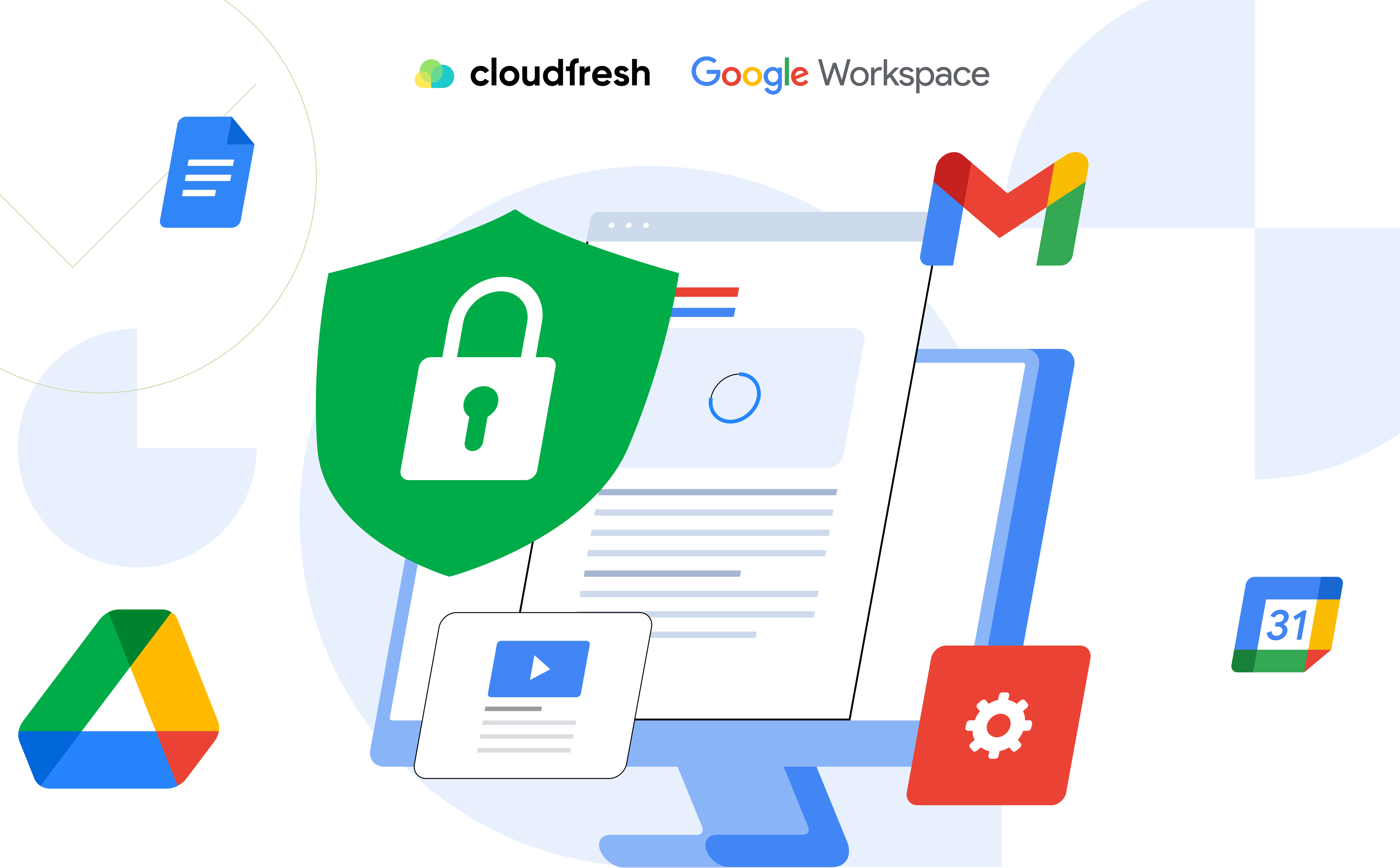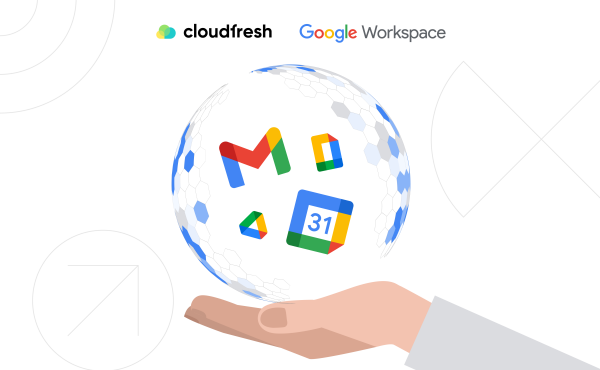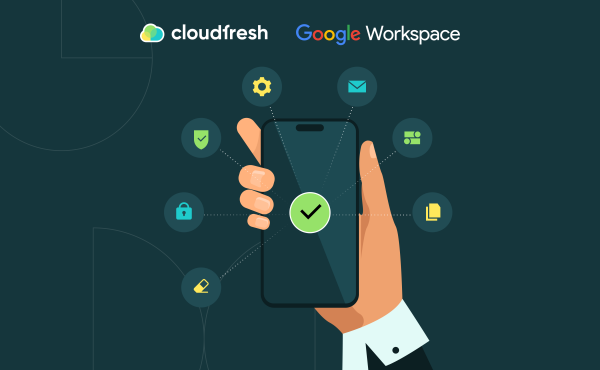Google Workspace Debuts AI: Top 6 Use Cases for Gemini in 2024
Understanding Data Loss Prevention (DLP) in Google Workspace
- Introduction
- What is Data Loss Prevention (DLP) in Google Workspace?
- Types of DLP Solutions
- How Google Workspace DLP System Works
- DLP Best Practices for Google Workspace

- Advanced Data Protection with Cloudfresh

Data loss is a huge problem for companies today, especially for those who use cloud-based collaboration tools like Google Workspace (formerly G Suite). With millions of users all over the world creating, editing, and sharing files on Google Drive every day, there is a risk of exposing or leaking sensitive data such as personal information, passwords, and trade secrets.
Implementing effective data loss prevention (DLP) measures is critical for protecting your organization’s important data stored in the cloud. Google Workspace offers built-in DLP tools that can help reduce the risks of data loss and leakage if properly configured and utilized.
We’ll take a detailed look at Google Workspace DLP security best practices — what it is, why it’s important, and how to deploy an effective strategy tailored to your organization’s needs.
We’ll show you that protecting your data doesn’t have to be complicated. By taking small, simple steps, you can build a strong defense against data loss and keep your company’s information secure.
What is Data Loss Prevention (DLP) in Google Workspace?
Simply put, data loss prevention is a set of tools and policies that help protect your organization’s sensitive data from inappropriate access, distribution, or leakage. It gives administrators control over data sharing and access in applications like Gmail, Drive, and Chat. Proper Google Workspace delegation can also play a crucial role in managing access to sensitive information.
The main goal of Google Workspace DLP is to detect and prevent the unauthorized transfer or disclosure of user’s information. This could include things like:
- Personal data (names, emails, phone numbers, etc.).
- Financial information (credit card numbers, bank accounts).
- Confidential business data (trade secrets, intellectual property).
DLP Google Workspace scans the content of files, emails, chats, and more to identify any sensitive data based on customizable policies and rules set by your administrator. If a potential data leak is detected, it can block the action, delete sensitive info, or provide access warnings to the user.
In addition to proactively preventing data leaks, DLP also provides reporting and analytics to understand risk levels and user behavior over time-related to sharing sensitive data. This insight allows you to train employees and improve policies.
Despite its power, Google’s built-in DLP only covers the Google Workspace environment. For comprehensive protection, you may need DLP solutions that cover cloud accounts and on-premises data.

Types of DLP Solutions
There are three main types of Google Workspace data loss prevention
solutions:
- network,
- endpoint,
- and cloud-based.
Each of these tools provides different Google Workspace data protection capabilities to meet unique business needs and requirements. Let’s take a closer look at them:
| Type | Description |
| Network | Focus on protecting data that moves across your company's network. It keeps an eye on data flows on the network, including emails, file transfers, and web traffic. It uses techniques such as machine learning to detect unusual network traffic that could signal a data leak or loss. However, network DLP provides visibility into data in motion and data at rest on the network. |
| Endpoint | Endpoint devices, such as laptops, desktops, and mobile devices, are common data leak points. Google MDM solutions are installed directly on these devices to monitor and control data usage and transmission. They can restrict activities like copying files to external drives, printing confidential documents, or uploading data to unauthorized cloud services. |
| Cloud | If your company stores data in the cloud, this type of DLP is essential. It scans and protects data stored in cloud services such as Google Workspace. Cloud DLP solutions can also apply encryption and access control to prevent unauthorized access to sensitive data in the cloud. |

Companies often deploy a combination of all three types for stronger data protection. The best approach depends on where sensitive data is stored and how it moves within the organization.
Network DLP protects data paths, endpoint DLP blocks device activity, and cloud DLP protects data on cloud platforms and in storage. Together, they provide overlapping layers of monitoring and control to prevent data loss incidents for your organization.
How Google Workspace DLP System Works
Data loss prevention is a multi-step process that involves:
- Setting Rules: Admins define DLP rules and policies from the admin console. Rules are configured to detect and respond to potential DLP violations or incidents. They can be as simple as preventing certain types of files from being shared externally, or as complex as using regular expressions to identify patterns of sensitive information.
- DLP Scan: DLP scans various file types, including documents, images, and compressed files. It scans content in applications such as Sheets, Docs, Slides, and Forms (for file uploads). For example, Google Drive DLP scans the workspace, including emails, documents, and other files, for any content that matches the defined rules. It uses pattern matching and machine learning techniques to identify sensitive information that matches the predefined rules.
- Action: When a potential violation is detected, Google Workspace DL> takes action based on the rules set by the administrator. This can include:
Blocking — preventing the sharing or sending of confidential information outside the company.
Warning – notifying the user that they are attempting to share sensitive information and giving them the option to proceed or modify the content.
Quarantine — moving content to a secure location for admins to review. - Alerts and Reporting: Administrators receive alerts about any DLP policy violations. These alerts typically contain information about the user, the content involved, and the action taken. Google Workspace provides a DLP Incident Management dashboard for reviewing and managing incidents.
DLP also offers additional features like content classification, which helps you categorize data based on its sensitivity, and data masking.
DLP Best Practices for Google Workspace
To prevent data loss, businesses should follow best practices for Google Workspace data protection, especially in the public cloud:
Cloud Backup Strategy
Securing your Google Workspace data begins with the step of securing your information, a practice that is often underestimated. Here’s why it holds significance:
- Backups serve as a shield against data loss, which accounts for more than half of all data loss incidents.
- They also protect against harming your data from individuals such as former employees or malicious hackers.
Frequent data backups are advisable. To ensure good Google Workspace data protection it is essential to have a backup mechanism in place. Consider the criteria:
- Automation: Utilize tools that automate the backup process to reduce manual intervention, surpassing the basic syncing capabilities of Google Workspace.
- Encryption: While Google Workspace encrypts data at rest and in transit, additional encryption measures through third-party tools can further secure your backups, meeting higher security standards or specific compliance requirements.
A robust backup system instills confidence when storing your data in the cloud by providing tailored protection measures.
Establishing Stringent Access Controls & Tracking Sensitive Data Sharing
When utilizing Google Drive, Google Docs or Google Sheets controlling access, the ability to edit permissions of your files is paramount. Here’s how you can manage this effectively:
- Utilize folders to organize your files and define permission settings at the folder level.
- To keep documents secure, opt to allow access to “Specific individuals” rather than “Anyone with a link.”
- Make sure to review and revise access permissions.
- Educate your team on practices for sharing files.
- Utilize the Google Workspace security center for monitoring file-sharing activities.
Keep in mind that limiting the number of people with access to information reduces the chances of leaks or unauthorized entry.
Turn On Two-Step Login
Two-step login (also known as two-factor authentication, or MFA) provides an additional layer of protection. Here’s why it’s important and how to apply it:
- It involves something you know (a password) and something you own (typically your phone).
- Even if they guess your password, they will be unable to log in without the second factor.
- To enable it, navigate to your Admin console settings and search for “2-step verification”.
- You can utilize physical security keys, text messages, or the Google Authenticator app.
- Make it required for all users of your Google Workspace.
Using Multi-factor Authentication makes it much harder for hackers to access your accounts.
Ransomware Protection
To protect against ransomware, you’ll need solutions that can act swiftly and without human intervention. Here’s what you should look for:
- Real-time tracking of file modifications and user actions.
- Able to detect strange encryption patterns.
- Automatically prohibit questionable IP-addresses or user accounts.
- Your security team receives instant notifications.
- Integrate with your current security tools.
With these features, you can stop many ransomware attacks before they do serious damage.
Fix Encrypted Files Automatically
Accelerate your recovery from ransomware attacks by ensuring your Google Workspace DLP is set up to:
- Automatically detect files that have been encrypted by ransomware.
- Have a recent backup of all your files ready to go.
- Quickly restore infected files to a pre-attack state.
- Do this without the manual input for each file.
- Provide a detailed report of what was affected and what was restored.
This automated approach saves time and reduces the potential damage from an attack.
Monitoring Account Activity
To protect your Google Workspace, you should use an automated tool that monitors what your employees and contractors are doing. This way, you can quickly notice any changes to sharing settings, track who is downloading sensitive data, and keep track of who is accessing third-party programs in your workspace. By using this tool, you can stop potential security issues before they become big problems and make sure your sensitive information stays safe.
Remember, good Google Workspace data protection is an ongoing process. Review and update your DLP rules and practices.
Advanced Data Protection with Cloudfresh
Data loss is a major risk for businesses that use Google Workspace and other cloud services to store and exchange critical information. Failure to establish effective Google Workspace data loss protection policies can have serious consequences, including regulatory compliance, data breaches, intellectual property loss, and other problems.
To enhance your DLP strategy for Google Workspace and safeguard your sensitive data, consider partnering with Cloudfresh, a Google Cloud Premier Partner. Our team of experts offers comprehensive Google Workspace services, including our Advanced Data Protection package designed to fortify your organization’s data security.
No wait until it’s too late. Contact Cloudfresh today to learn more about our services and and how we can help safeguard your organization’s critical information in Google Workspace.















